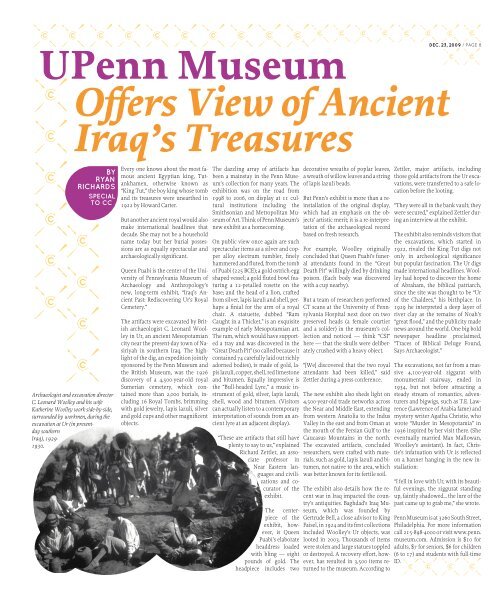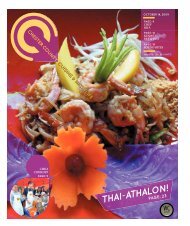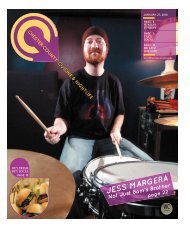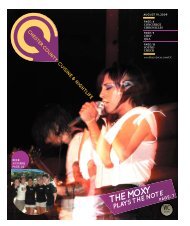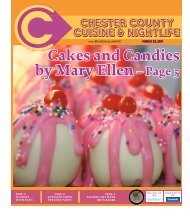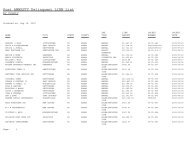Create successful ePaper yourself
Turn your PDF publications into a flip-book with our unique Google optimized e-Paper software.
xxxxxxxxxxxxxxxxxxxUPenn MuseumxxOffers View of AncientxxIraq’s TreasuresxxxxxxxxxxxxxxxxxxxxBYRYANRICHARDSSPECIALTO <strong>CC</strong>Archaeologist and excavation directorC. Leonard Woolley and his wifeKatherine Woolley work side-by-side,surrounded by workmen, during theexcavation at Ur (in presentdaysouthernIraq), 1929-1930.Every one knows about the most famousancient Egyptian king, Tutankhamen,otherwise known as“King Tut,” the boy king whose tomband its treasures were unearthed in1922 by Howard Carter.But another ancient royal would alsomake international headlines thatdecade. She may not be a householdname today but her burial possessionsare as equally spectacular andarchaeologically significant.Queen Puabi is the center of the Universityof Pennsylvania Museum ofArchaeology and Anthropology’snew, long-term exhibit, “Iraq’s AncientPast: Rediscovering Ur’s RoyalCemetery.”The artifacts were excavated by Britisharchaeologist C. Leonard Woolleyin Ur, an ancient Mesopotamiancity near the present-day town of Nasiriyahin southern Iraq. The highlightof the dig, an expedition jointlysponsored by the Penn Museum andthe British Museum, was the 1926discovery of a 4,500-year-old royalSumerian cemetery, which containedmore than 2,000 burials, including16 Royal Tombs, brimmingwith gold jewelry, lapis lazuli, silverand gold cups and other magnificentobjects.The dazzling array of artifacts hasbeen a mainstay in the Penn Museum’scollection for many years. Theexhibition was on the road <strong>from</strong>1998 to 2006, on display at 11 culturalinstitutions including theSmithsonian and Metropolitan Museumof Art. Think of Penn Museum’snew exhibit as a homecoming.On public view once again are suchspectacular items as a silver and copperalloy electrum tumbler, finelyhammered and fluted, <strong>from</strong> the tombof Puabi (225 BCE); a gold ostrich-eggshaped vessel; a gold fluted bowl featuringa 12-petalled rosette on thebase; and the head of a lion, crafted<strong>from</strong> silver, lapis lazuli and shell, perhapsa finial for the arm of a royalchair. A statuette, dubbed “RamCaught in a Thicket,” is an exquisiteexample of early Mesopotamian art.The ram, which would have supporteda tray and was discovered in the“Great Death Pit” (so called because itcontained 74 carefully laid out richlyadorned bodies), is made of gold, lapislazuli, copper, shell, red limestoneand bitumen. Equally impressive isthe “Bull-headed Lyre,” a music instrumentof gold, silver, lapis lazuli,shell, wood and bitumen. (Visitorscan actually listen to a contemporaryinterpretation of sounds <strong>from</strong> an ancientlyre at an adjacent display).“These are artifacts that still haveplenty to say to us,” explainedRichard Zettler, an associateprofessor inNear Eastern languagesand civilizationsand cocuratorof theexhibit.The centerpieceof theexhibit, however,is QueenPuabi’s elaborateheaddress loadedwith bling — eightpounds of gold. Theheadpiece includes twoxxxxxxxxDEC. 23, 2009 / PAGE 8decorative wreaths of poplar leaves,a wreath of willow leaves and a stringof lapis lazuli beads.But Penn’s exhibit is more than a reinstallationof the original display,which had an emphasis on the objects’artistic merit; it is a re-interpretationof the archaeological recordbased on fresh research.For example, Woolley originallyconcluded that Queen Puabi’s funeralattendants found in the “GreatDeath Pit” willingly died by drinkingpoison. (Each body was discoveredwith a cup nearby).But a team of researchers performedCT scans at the University of PennsylvaniaHospital next door on twopreserved heads (a female courtierand a solider) in the museum’s collectionand noticed — think “CSI”here — that the skulls were deliberatelycrushed with a heavy object.“[We] discovered that the two royalattendants had been killed,” saidZettler during a press conference.The new exhibit also sheds light on4,500-year-old trade networks acrossthe Near and Middle East, extending<strong>from</strong> western Anatolia to the IndusValley in the east and <strong>from</strong> Oman atthe mouth of the Persian Gulf to theCaucasus Mountains in the north.The excavated artifacts, concludedresearchers, were crafted with materials,such as gold, lapis lazuli and bitumen,not native to the area, whichwas better known for its fertile soil.The exhibit also details how the recentwar in Iraq impacted the country’santiquities. Baghdad’s Iraq Museum,which was founded byGertrude Bell, a close advisor to KingFaisel, in 1924 and its first collectionsincluded Woolley’s Ur objects, waslooted in 2003. Thousands of itemswere stolen and large statues toppledor destroyed. A recovery effort, however,has resulted in 3,500 items returnedto the museum. According toZettler, major artifacts, includingthose gold artifacts <strong>from</strong> the Ur excavations,were transferred to a safe locationbefore the looting.“They were all in the bank vault; theywere secured,” explained Zettler duringan interview at the exhibit.The exhibit also reminds visitors thatthe excavations, which started in1922, rivaled the King Tut digs notonly in archeological significancebut popular fascination. The Ur digsmade international headlines. Woolleyhad hoped to discover the homeof Abraham, the biblical patriarch,since the site was thought to be “Urof the Chaldees,” his birthplace. In1929 he interpreted a deep layer ofriver clay as the remains of Noah’s“great flood,” and the publicity madenews around the world. One big boldnewspaper headline proclaimed,“Traces of Biblical Deluge Found,Says Archaeologist.”The excavations, not far <strong>from</strong> a massive4,100-year-old ziggarat withmonumental stairway, ended in1934, but not before attracting asteady stream of romantics, adventurersand bigwigs, such as T.E. Lawrence(Lawrence of Arabia fame) andmystery writer Agatha Christie, whowrote “Murder in Mesopotamia” in1936 inspired by her visit there. (Sheeventually married Max Mallowan,Woolley’s assistant). In fact, Christie’sinfatuation with Ur is reflectedon a banner hanging in the new installation:“I fell in love with Ur, with its beautifulevenings, the ziggurat standingup, faintly shadowed… the lure of thepast came up to grab me,” she wrote.Penn Museum is at 3260 South Street,Philadelphia. For more informationcall 215-898-4000 or visit www.penn.museum.com. Admission is $10 foradults, $7 for seniors, $6 for children(6 to 17) and students with full-timeID.xxxxxxxxxxxxx


